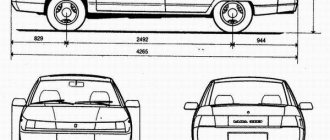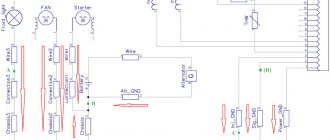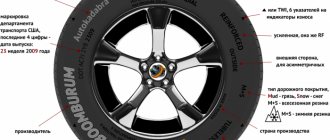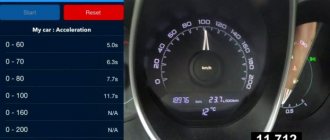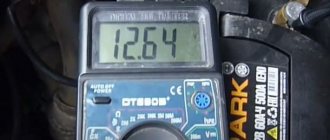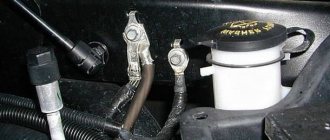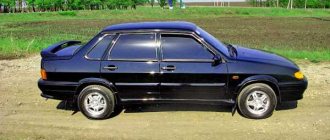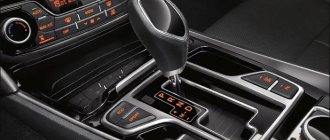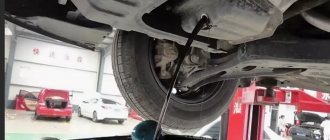Many car enthusiasts are well aware of such concepts as curb weight, gross weight and maximum permissible vehicle weight. As a rule, the curb weight of a car is usually indicated in the registration certificate, and this indicator is also reflected in the list of the main technical characteristics of the vehicle model. The same can be said about the total mass.
At the same time, quite often a certain confusion arises among non-professionals in this matter. If we also add to this concepts such as maximum permitted weight, estimated weight and nominal weight of the car, in this case even an experienced driver may not give an accurate answer.
Next, we will look at what the curb weight of the vehicle is, the gross vehicle weight, and also what the definition of “maximum permissible weight” is, etc.
Differences between curb, gross and maximum permissible vehicle weight
- Differences between curb, gross and maximum permissible vehicle weight
- What is the curb weight of the car
- Payload weight
- Maximum permissible (gross) weight
The weight characteristics of a car are the primary criterion for fuel consumption and other indicators, which also affects all kinds of car systems. Basic concepts regarding vehicle masses are usually taught in driving school. However, for many car owners this is a difficult question. In this article we will tell you the difference between gross curb weight and what it is; We will also find out what the payload mass and the maximum permissible mass are.
- What is the curb weight of the car
- Payload weight
- Maximum permissible (gross) weight
What is the curb weight of the car
The curb weight of the vehicle is the weight of the vehicle, which takes into account the weight of standard equipment (spare wheel, tools), the weight of all operating materials (fuel, coolant, oil, etc.), but does not take into account the weight of cargo, driver and passengers. In other words, the total value of the masses of all components of an empty vehicle filled to a full tank, which has all the standard equipment and the required fluid levels, means the curb weight of the vehicle.
The curb weight is also called the unladen weight, while the gross vehicle weight is considered to be the weight that includes the weight of equipment, consumables, as well as the weight of the driver, the weight of passengers and cargo. That is, the difference between the gross and curb weights lies in the weight of the driver, passengers and cargo carried by the vehicle.
Let us also mention such a concept as the dry weight of a car. This is the real weight of the machine as a structure, device, mechanism. In other words, this is the total actual weight of the unladen vehicle without any consumable fluids.
Payload weight
Now we will talk about such an important technical and basic operational characteristic of vehicles as carrying capacity, in other words, the mass of the payload. This is the total weight of all the cargo (corresponding to the general technical and operational characteristics of the vehicle) that the vehicle transports. By establishing the permissible maximum axle load of the rolling stock per meter of track, the estimated payload weight of the vehicle can be determined.
Conventionally, the load capacity can be divided into
calculated and nominal . If the calculated one takes into account only the permissible weight that the vehicle can carry, then the nominal one also takes into account the quality of the road. On hard surfaces it can range from 0.5 tons (for passenger cars) to more than 28 tons (for dump trucks).
Maximum permissible (gross) weight
If we talk about the permissible maximum weight of the vehicle, then this is the weight of the equipped and extremely loaded vehicle, as provided by the developer. The weight of the driver and passengers is also taken into account. Each make and model has its own maximum permissible weight, which depends on the materials used in the production of the car, the body structure and other parts of the car.
The traffic rules also state that the subpermissible maximum weight of a road train means the sum of the maximum permissible weights of all vehicles that make up the train. It is also worth mentioning that since 2015, the Cabinet of Ministers of Ukraine has introduced some restrictions for trucks aimed at preserving the integrity of the roadway. As stated in Decree No. 8669 of October 21: for the transportation of divisible goods, the permissible maximum weight of a truck is no more than 40 tons, which applies to public roads.
As you can see, all the concepts are extremely simple and understandable. We hope that all of the above will be useful to you and there will be no confusion.
Subscribe to our feeds on social networks such as Facebook, Vkontakte, Instagram, Pinterest, Yandex Zen, Twitter and Telegram: all the most interesting automotive events collected in one place.
What's the result?
As you can see, the concept of vehicle mass may differ. It is important to understand exactly what weight of the car we are talking about in each specific case (curb, gross, permitted, dry weight, calculated, nominal, etc.). At the same time, the above information allows you to better understand this issue, which in certain situations eliminates common mistakes.
We also recommend reading what car engine torque is. From this article you will learn about the difference between internal combustion engine power and torque, as well as what these parameters influence.
Finally, we note that many cars, both cars and trucks, have special plates on the body. These signs often provide useful information about what tire pressure should be maintained, as well as what the gross vehicle weight is.
This data makes it possible to increase safety when transporting passengers and cargo, and it is also possible to more accurately understand how much cargo can be transported in a particular car, adjusted for the characteristics declared by the car manufacturer in terms of carrying capacity. In turn, this will allow you to avoid accidentally overloading the car and premature breakdowns or severe wear and tear on the components and assemblies of the vehicle.
Vehicle weight: loaded and unloaded
So, let's start with the fact that the weight of the car can be curb and full. This is exactly the information contained in the technical passport of the vehicle. To put it simply, the weight of a car greatly affects its dynamic characteristics, fuel consumption, etc. It turns out that this criterion has a direct impact on a number of important indicators. For this reason, it must be indicated.
- So, the curb weight of a car is the weight of the vehicle without load. In turn, the gross vehicle weight is the weight taking into account the maximum permissible design load. To clearly understand the difference between gross weight and curb weight, it is enough to consider a simple example.
In other words, to understand what the curb weight of a car is, it is enough to imagine a fully fueled and fully equipped car, in which there are no passengers or cargo. It turns out that this parameter does not take into account the mass of payload that the car can carry.
By the way, in some EU countries an additional 75 kg is included in the curb weight, which represents the average weight of the driver. This means that in some cases the driver's weight may still be included in the curb weight. The logic in this case is that the presence of a driver is a prerequisite for the vehicle to move, that is, the driver’s weight cannot be considered a separate payload.
- In turn, the gross weight is the total weight of the equipped vehicle, passengers and driver, as well as the cargo that a particular vehicle is capable of carrying. It turns out that the curb weight is the weight of the car without any load at all (except for cases where the driver’s weight is also taken into account as the curb weight). In turn, the maximum permissible (gross) weight is the weight of the vehicle, the driver and passengers in the cabin, as well as cargo.
So, the permissible maximum weight or the maximum permissible (gross) weight of a vehicle is the weight of a curbed and fully loaded vehicle, which is allowed by the vehicle manufacturer itself.
Let’s add that in order to understand how much weight can be transported, the weight of the maximum permissible load on each axle of the car is important. Such data is in the technical specifications; there may also be a special information plate attached to the car body.
- Let us also add that there is also the concept of the mass of only the car itself (the so-called dry mass). In fact, this is the weight of the car without taking into account the filled technical fluids. This parameter does not greatly affect daily operation. However, that's not all. As for the weight of the car, in some cases you still need to know what the payload mass is.
This parameter is also an important technical and operational characteristic. In simple words, the payload mass is the carrying capacity of the vehicle (the total weight of all the cargo that a particular vehicle can carry). Often this concept is equated to total mass.
The load capacity itself can be calculated or nominal. In this case, the carrying capacity determines only the maximum permissible weight that can be transported, while the nominal capacity separately takes into account the quality of the road surface.
To summarize, the most important indicators are:
- curb weight - the weight of a vehicle ready for operation with standard equipment, but excluding the weight of passengers, driver and cargo;
- dry weight – the weight of an unloaded car (without fuel, technical fluids and some equipment);
- maximum weight or permissible gross weight - the permissible weight of the maximum loaded vehicle (driver, passengers and cargo), which is provided by the car manufacturer itself;
Useful tips
In practice, car owners do not often wonder about the maximum permissible weight of the car. As a rule, cars are simply loaded and then transported, without taking into account the maximum permissible weight. However, if the owner cares about the health of the vehicle and aims to preserve the resource and increase the service life of the vehicle as a whole, this indicator cannot be ignored.
The reason is quite obvious, since if the permissible weight is exceeded, there is an increased load on the body, engine, transmission, chassis and suspension of the car. Under severe overload, literally everything in the car wears out and quickly fails, from the engine and gearbox to shock absorbers, wheel bearings, brake discs and brake pads.
We also recommend reading the article about how the efficiency of a gasoline and diesel engine differs. From this article you will learn about why these motors have strong differences in terms of efficiency, as well as what pros and cons are typical for these power plants.
It should also be taken into account that at maximum load, even within acceptable limits, the load on the clutch and transmission increases noticeably, and the brakes are also heavily loaded. Even greater weight may have a noticeable effect on the vehicle's handling and stability on the road.
When loading, it is important to correctly distribute loads along the axles, and also take into account the maximum permissible load on each side or even wheel. For example, manufacturers of tires and cars themselves specifically indicate what load a particular tire can withstand, what pressure should be maintained taking into account different loads, etc.
Why is it necessary to know the curb weight of a car?
There are many situations in which you may need information about your vehicle's curb weight. First of all, it's towing. Each car has a maximum towed load limit. If you ask to tow a car that technically cannot pull your car, you will have to deal with various problems later. You should remember about the curb weight of the car in those situations when you drive through dangerous places, local bridges over small rivers. Some of these places even have warnings with vehicle weight restrictions. Therefore, you should always follow these rules:
- when purchasing a car, you should immediately find out its curb weight, which is indicated by the manufacturer;
- you need to find out the formula by which the curb weight was calculated and remember the figure;
- if necessary, you can estimate the weight of the car by adding the weight of the people in the car to the mass value;
- also do not forget about situational luggage that is not included in the curb weight of your car;
- There is no need to worry about fuel, oil, fire extinguisher and first aid kit - these elements are already taken into account in the indicators.
As you can see, it is necessary for the car owner to know the curb weight. This is one of the important points of technical characteristics, which takes into account all the subtleties, which sometimes add up to 500 kilograms. You will never calculate the optimal weight of a car if you only know the net weight. But find out whether the driver's weight factor was involved in calculating the curb weight for your car. This can be clarified with the official dealer or on the manufacturer’s website in the technical support of the owners.
An excursion into the history of the establishment of restrictions on the size of trucks
The main regulatory document regarding restrictions on the size of trucks in Europe is EU Council Directive No. 96/53/EC. The first countries of the old world to change the permissible length and weight of road trains to 25.25 m and 60 tons were Sweden and Finland. In these countries, the operation of two types of road trains is permitted: those formed from a three-axle tractor and a 5-axle trailer, made on the basis of a serial 3-axle semi-trailer with a 2-axle dolly, and fifth-wheel trains (SPA), where a 2-axle trailer is attached to a serial semi-trailer. trailer, usually with a central axle. New types of road trains appeared on domestic roads quite a long time ago. They run between the cities of Sweden, Finland and St. Petersburg, Moscow. As part of international transport, these vehicles should also have appeared, but the legislation of European countries (with the exception of Sweden and Finland) is not so perfect as to quickly change the restrictions on the dimensions of cargo cars. The situation is similar in the CIS countries. The useful volume of such road trains reaches 160 cubic meters. The Scandinavian states did not immediately come to the length of road trains of 25.5 meters. At first they were able to allow trucks 24 meters long. There are currently no standards defining permissible weight standards for trucks and tractor-trailers in the post-Soviet space. The only suitable GOST was canceled more than 25 years ago. According to it, the total weight of a 5-axle truck or single-trailer road train should not exceed 40 tons, length 20 meters, and with two trailers - 24 meters. Experts consider the “Agreement on the masses and dimensions of vehicles engaged in interstate transportation on the roads of the CIS member countries,” which came into force on June 4, 1999, to be contradictory and thoughtless. The maximum permissible weight of a road train under this “agreement” should be 44 tons. Even in North American countries, where the most stringent standards in the world apply to axle loads and weights of road trains, this figure is 48 tons. The situation is similar with a 6-axle semi-trailer train, the weight of which should not exceed 38 tons. Moreover, in the European Union, according to EU Directive No. 96/53, the permissible weight of a road train is 44 tons. China has the most liberal attitude towards the size of trucks. Any restrictions there exist only on paper. According to documents, standards similar to EU Directive No. 96/53/EC are regulated, but there are “monsters” of enormous size on the roads. In North America, a semi-trailer must not exceed 16.15 m in length and 2.6 m in width. In Europe, similar restrictions are stricter: length - 13.6 m, width - 2.6 m. Due to similar disagreements regarding acceptable standards The process of transporting goods by containers is becoming more complicated. Thus, 45, 48 and 53 foot containers are not found in Europe at all, although they are widely used in the USA and Canada.
What is a vehicle passport and why is it needed?
A vehicle passport (PTS) is one of the main documents for a car, which contains information about the technical characteristics of the car, information about the owners and registration/deregistration of the vehicle.
Photo: PTS sample
The PTS was approved by Order of the Ministry of Internal Affairs of the Russian Federation, the Ministry of Industry and Energy of the Russian Federation and the Ministry of Economic Development and Trade of the Russian Federation dated June 23, 2005 N496/192/134 “On approval of the Regulations on vehicle passports and vehicle chassis passports.”
The vehicle passport is a document of strict accountability and is printed on blue forms produced by the Gosznak enterprise. All forms have a security stripe and special watermarks.
PTS can be issued by the following authorities:
- Customs. When transporting a car across the border.
- Traffic police authorities. In case of replacement or loss of PTS.
- Manufacturing plants. When purchasing a car for the first time.
The PTS contains 24 columns:
- VIN (identification number). Typically, it consists of 17 numbers and letters. These are the factory specifications of the car.
- Car make and model. The name and brand can be entered in both Russian and English.
- Type of vehicle (car, truck, motorcycle, etc.).
- Vehicle category (A, B, C, D, E).
- Year of car manufacture.
- Engine model and number.
- Chassis, frame.
- Body. We are talking about a number that may be similar to the VIN, or, for example, for American cars that are intended for the domestic market, different.
- Body color.
- Engine power (hp).
- Engine displacement (cc. cm).
- Engine's type.
- Permitted maximum vehicle weight.
- Weight without load (kg).
- Manufacturer country.
- Vehicle type approval. In other words, environmental class: Euro 1, 2, 3, 4, 5.
- Country of export of the vehicle.
- Series, customs declaration number.
- Customs restrictions.
- Name and full name of the owner of the car.
- Address.
- The organization that issued the PTS.
- Address of the organization that issued the PTS.
- Date of issue of PTS.
In addition to the above information, the car's PTS can include information about all owners of the car, changes in the technical characteristics of the vehicle, and the issuance of a duplicate PTS.
Copies of passports made by any method, including photocopies or blueprints, cannot serve as a substitute for original passports.
European emission standards for diesel truck engines
UN General Assembly emission requirements for heavy trucks equipped with a diesel engine, g/(kWh) Each truck must be marked in accordance with its standard. Letters of the Latin alphabet are used for designation.
| Standard (year) | Carbon monoxide - CO | Hydrocarbons – HC | Nitric oxide – N0x | Smokiness – Smoke |
| Euro 0 (1988) | ||||
| Euro 1 (1992) | ||||
| Euro 2 (1996) | ||||
| Euro 3 (2000) | ||||
| Euro 4 (2005) | ||||
| Euro 5 (2008) | ||||
| Euro 6 (2013) |
A vehicle that meets the relevant requirements is indicated by a letter placed on the cab or bumper of the truck:
- U – “Umwelt” (“Nature”), Euro-1 standard,
- E – “Green Lorry” (“Green Truck”). The concept of “Green Lorry” includes the following requirements: pollutant emission standards EURO-2, noise standards - 78-80 dBA. A certificate of conformity is filled out on such a truck and a U or E plate is installed.
- S – “Supergreen” (“Very green”), Euro-2 standard
- G - "Greener and Safe Lorry"
- L - "Larmarm Kraftfahzeuge" (low noise tractor) in Austria, since December 1, 1989, a truck driving at night (from 22:00 to 5:00) in Austria must comply with these noise standards.
Since 2001, another definition of a motor vehicle has been introduced - “EURO-3 safe”, it has been in force since 2002. Such a truck must comply with EURO-3 emissions standards, and the usual noise level is 78-80 dBA. Then a green sign with a white border and a white number 3 is hung. For cars that comply with “EURO-4” and “EURO-5” the signs are green with a white border and the numbers 4 and 5.
All of the above signs must be confirmed by a certificate from the manufacturer and be on board the vehicle.
Why is it necessary to know the curb weight of the car?
There are many situations in which knowledge about the curb weight of a car may be needed. First of all, this is towing, since each vehicle has a maximum permissible weight of towed cargo.
It is also worth remembering this value in situations where the car is driving through local bridges over rivers or dangerous places. Often at such places there are warnings that contain information about vehicle weight restrictions. Therefore, experts recommend following some rules:
- If necessary, estimate the weight of the car, add the weight of the driver and all passengers to the weight of the car.
- When buying a car, immediately find out the curb weight specified by the manufacturer.
- You should find out the formula that was used to calculate the curb weight, remember or write down this figure.
- No need to worry about fuel, oil, first aid kit, fire extinguisher - these elements are automatically taken into account in the indicators.
- Do not forget about luggage that is not taken into account in the curb weight of the car (situational luggage).
From this information it is worth concluding that the curb weight indicator is important information and it is necessary for the car owner to know it. This is one of the important parameters of technical characteristics, which sometimes takes into account up to 500 kg of additional weight of the car.
You will never be able to calculate the optimal weight of your car if you only know its dry weight.
Legislation and general provisions
Heavy vehicles place a serious burden on the road surface. To minimize its damage and ensure road safety, restrictions on the maximum weight of a truck were developed and liability was introduced for violating them.
In the Russian Federation, these standards are given in Federal Law No. 257 and Government Decree No. 272. The State Traffic Inspectorate is responsible for monitoring compliance with the standards.
Truck drivers should pay attention to the following points:
- The rules apply exclusively on public roads of territorial or federal significance.
- Overloaded vehicles should only be driven on special roads.
- If the roadway is not able to withstand the load established by law, its owner has the right to set his own restrictions.
- Before reducing the maximum permissible vehicle weight restrictions, a survey of the condition of the road surface must be carried out.
- On highways with restrictions for heavy vehicles, road signs should be installed to warn drivers about this.
- Axle load standards depend on the vehicle operating instructions.
New PTS standard
The paper vehicle passport (PTS) in its current form, which we are accustomed to, appeared in 1993. Before this, the only document for a car was a registration certificate, which included not only basic information about the car, but also registration data, as well as inspection marks. If, for example, a car was stolen along with its registration certificate, the car owner was left without any documents for the car. In this regard, a new standard emerged, according to which each car owner received three documents: a vehicle passport (PTS), which you do not need to carry with you, a registration certificate and a technical inspection card.
Over time, the PTS has acquired many additions and today, in addition to basic information about the car, its owner and registration data, it can tell about changes in the design of the car, significant damage after accidents, payment of a recycling fee, and so on. It’s already quite difficult to fit all this on A4 paper.
Another incentive for the creation of a new PTS standard was the formation of the Eurasian Economic Union: the new passport should become uniform in Russia, Belarus, Kazakhstan, Kyrgyzstan and Armenia. The corresponding agreement was signed in 2014. Created within the structure of the Rostec State Corporation, it was appointed as the developer and operator.
There is no mandatory exchange of a paper PTS for its electronic version - car owners who have cars with paper passports will be able to continue to use them. The transition period is valid until November 1, 2022, after which paper vehicle registration certificates will not be issued for new vehicles.
Moments of inertia
With the same position of the center of mass and equal masses, cars can have different values of moments of inertia. In general, the inertial properties of the structure, along with the above mass indicators, can be characterized by three values of the moments of inertia (relative to three mutually perpendicular axes passing through the center of mass). The moment of inertia about the vertical axis has a great influence on the vehicle's handling and its stability against skidding. The moment of inertia about the horizontal transverse axis affects the smoothness of the vehicle. The moment of inertia about the horizontal longitudinal axis can affect the vehicle's stability against lateral rollover.
During the design process, the designer has the opportunity to influence the values of the vehicle’s moments of inertia mainly due to changes in its layout.
Which cars are classified as passenger cars by purpose?
The qualities that are endowed with all the most popular (including passenger) models today were developed through trial and error. The history of the automotive industry goes back more than 100 years, and all this time there has been continuous development.
Improvement went in the following directions:
ease of production;
availability of luggage space, capacity level;
passenger and driver comfort;
ease of use and management, affordability.
In the course of “evolution” we received models that today are classified as passenger cars:
from 3 to 5 doors (from hatchbacks and sedans to station wagons);
with 4-5 seats in the cabin, where two are required in the front - for the driver and one passenger;
with luggage compartment;
with one (usually front-wheel drive).
Cars are also classified according to their purpose:
Passenger cars.
This category includes small-sized vehicles with a small cargo capacity, intended for transporting passengers on city roads. This class has low cross-country ability, and it is not advisable to direct it away from the adapted road surface. Sports cars can also be classified as passenger cars.
This type of passenger car is not suitable for racing; everything is aimed at providing the owner with comfortable and convenient driving. The “sportiness” of the car is determined by a wide range of additions. This subclass includes both ordinary vehicles with a “sports body kit” and full-fledged highly dynamic versions.
SUVs.
These vehicles have high cross-country ability and, thanks to their design, can easily move off-road. A widely popular segment includes crossovers (the so-called parquet SUVs), which, in fact, are an intermediate link between SUVs and passenger cars.
The cross-country ability of such vehicles is higher than that of “passenger” vehicles, but they cannot be classified as full-fledged SUVs. Crossovers do not have the equipment that would allow them to overcome off-road conditions without problems.
Commercial.
Such passenger cars are structurally manufactured in the likeness of passenger cars, but are not classified as passenger cars. Their purpose is small commercial cargo transportation.
An interesting trend has emerged, according to which such cars are gradually being functionally returned to passenger cars. For example, the Citroen Berlingo, which belongs to the cargo class, with a free compartment of 3 m3 behind the front seats, when updated in Multispace, received rear passenger seats instead of a roomy “trunk”. It differs from the traditional “passenger” version in its high ceiling and more spacious interior.
Examples of calculations for various cars
Let's look at a few examples of calculating the type of car:
Example 1. Renault Logan car
RMM = 1800 MBN = 1425 HRC = 4
RMP = 4 * 68 = 272 kg RMG = 1800 - 1425 - 272 = 103 kg
The estimated passenger weight exceeds the cargo weight, so the car is a passenger car .
Example 2. Cargo Gazelle van (GAZ 2705 - 7 seats)
RMM = 3500 MBN = 2090 HRC = 6
RMP = 6 * 68 = 408 kg RMG = 3500 - 2090 - 408 = 1002 kg
The estimated cargo weight exceeds the passenger weight, so the vehicle is a cargo vehicle .
Example 3. Gazelle cargo truck with body (GAZ 3302)
RMM = 3500 MBN = 1850 KPC = 2
RMP = 2 * 68 = 136 kg RMG = 3500 - 1850 - 136 = 1514 kg
The estimated cargo weight exceeds the passenger weight, so the vehicle is a cargo vehicle .
Example 4. Volkswagen Amarok pickup truck
RMM = 3040 MBN = 1968 HRC = 4
RMP = 4 * 68 = 272 kg RMG = 3040 - 1968 - 272 = 800 kg
The estimated cargo weight exceeds the passenger weight, so the vehicle is a cargo vehicle .
Example 5. Toyota Land Cruiser 200 (5 seats)
RMM = 3300 MBN = 2585 HRC = 4
RMP = 4 * 68 = 272 kg RMG = 3300 - 2585 - 272 = 443 kg
The estimated cargo weight exceeds the passenger weight, so the vehicle is a cargo vehicle .
Example 6. Toyota Land Cruiser 200 (7 seats)
RMM = 3300 MBN = 2585 HRC = 4
RMP = 6 * 68 = 408 kg RMG = 3300 - 2585 - 408 = 307 kg
The estimated passenger weight exceeds the cargo weight, so the car is a passenger car .
Examples 5 and 6 are quite illustrative. They consider the same car model (Toyota LC200). The only difference is that the calculation was carried out for 5-seat and 7-seat cabins. At the same time, the 5-seater version turned out to be a cargo version, and the 7-seater version turned out to be a passenger one.
“Category” of car tax
The size of the transport tax rate primarily depends on the category to which this or that “iron horse” belongs. Who would have thought that it was with the definition of this indicator that accountants could have serious problems.
Article 14 of the Tax Code classifies transport tax as a regional tax. This means that it is established and put into effect not only by the Code, but also by the laws of the constituent entities of the Russian Federation and is obligatory for payment in the territory of the corresponding region. Tax payers are persons to whom, in accordance with the law, vehicles are registered that are recognized as an object of taxation in accordance with Article 358 of the Code. In this case, the tax base for cars with engines is determined as the power of the engine. Paragraph 1 of Article 359 of the Tax Code stipulates that tax rates are set by regional authorities depending on the engine power, as well as its category. This is where the questions begin.
Where is the dog buried?
According to the provisions of Article 358 of the Code, the categories of vehicles for which the corresponding tax rates are established include, in particular, cars and trucks, motorcycles, scooters, buses and other self-propelled machines and mechanisms on pneumatic and tracked tracks. However, according to the technical passport, which is compiled for each car, there can be only five categories - A, B, C, D and trailer. However, there is one more line in the passport - “Name (vehicle type)”, which indicates the exact characteristics of the vehicle, for example, “passenger car”, “bus”, “truck”, etc.
As a result, there are often situations when the registration certificate may indicate: “Vehicle category: “B”, vehicle type: “truck” (or “bus”, or even “special”). And although category “B” is established for passenger cars, this, for example, also includes small trucks weighing up to 3.5 tons. It is this “cargo accessory” that, as a rule, “pops up” in the type of vehicle. Of course, it is more profitable for taxpayers to ignore the second definition and pay tax at the rate provided for a passenger car. However, auditors in such a situation, despite the category “B” indicated in the registration certificate, require paying tax as for a truck.
"Leadership" chaos
Meanwhile, from a literal reading of Article 361 of the Tax Code, which regulates the calculation of transport tax, it absolutely does not follow that the rate must be determined taking into account the type of car. Moreover, the Tax Code does not contain any reference to the procedure for determining the category of a car. According to the Methodological Recommendations of the same tax authorities on the application of Chapter 28 “Transport Tax”, approved by Order of the Ministry of Taxes of April 9, 2003 No. BG-3-21/177, in this case you need to be guided by the following documents. Firstly, it is necessary to take into account the All-Russian Classifier of Fixed Assets OK 013-94 (OKOF), approved by Decree of the State Standard of December 26, 1994 No. 359 (hereinafter referred to as the All-Russian Classifier). Secondly, the provisions of the Convention on Road Traffic (Vienna, November 8, 1968, hereinafter referred to as the Convention), ratified by Decree of the Presidium of the Supreme Soviet of the USSR of April 29, 1974 No. 5938-VIII, should be taken into account. In practice, inspectors often also “bring in” the Industry Standard OH 025 270-66 “Classification and designation system for automotive rolling stock, as well as its units and assemblies produced by specialized enterprises” (hereinafter referred to as the Industry Standard). At the same time, in fact, tax authorities in each specific case refer to a document that is “convenient” at the moment.
Unfortunately, the judges do not have a unified position on this issue. Arbitrators can either exempt a company from paying additional tax assessed by the inspection, being content with a reference to category “B” (resolution of the Federal Antimonopoly Service of the West Siberian District dated June 13, 2007 No. F04-4154/2006(35097-A81-26), dated April 4, 2007 . in case No. F04-1859/2007 (32961-A75-15), and refuse to recognize such a decision of the tax authorities as invalid (resolution of the Federal Antimonopoly Service of the Volga-Vyatka District dated April 24, 2006 in case No. A29-3981/2005a). In cases where the technical passport data is insufficient, judges recognize the use of the All-Russian Classifier as legitimate (resolution of the Federal Antimonopoly Service of the Ural District dated December 19, 2007 No. F09-10585/07-S3, dated July 24, 2007 No. F09-5697/07-S3). friend - note that this normative act regulates other legal relations not related to taxation (resolution of the Federal Antimonopoly Service of the East Siberian District dated October 24, 2006 in case No. A10-1939/06-Ф02-5462/06-С1). A similar situation It also develops around the Industry Standard, so when going to court you cannot be completely confident in the outcome of the trial.
Maximum load on a truck axle in Russia
Another parameter controlled by this regulatory act (Appendix No. 2) is the permissible axle load. It is regulated for roads designed for 6 tons, 10 tons and 11.5 tons, respectively. The distance between closely spaced axles and the type of wheels (single or double) are also important.
Table 2018-2019
| Location of vehicle axles | Distance between adjacent axes (meters) | Permissible axle loads of wheeled vehicles depending on the standard (calculated) axle load (tons) and the number of wheels on the axle |
| for a/d, calc. for axle load 6 tons/axle | for a/d, calc. for axle load 10 tons/axle | for a/d, calc. for axle load 11.5 tons/axle |
| Singles | from 2.5 m or more | |
| Twin axles of trailers, semi-trailers, trucks, tractor units, truck tractors with the distance between the axles (load on the bogie, sum of axle masses) | up to 1 (inclusive) | |
| from 1 to 1.3 (inclusive) | ||
| from 1.3 to 1.8 (inclusive) | ||
| from 1.8 to 2.5 (inclusive) | ||
| Triple axles of trailers, semi-trailers, trucks, tractor units, truck tractors with the distance between the axles (load on the bogie, sum of axle masses) | up to 1 (inclusive) | |
| up to 1.3 (inclusive) | ||
| from 1.3 to 1.8 (inclusive) | ||
| from 1.8 to 2.5 (inclusive) | ||
| Closed axles of trucks, tractor-trailers, truck tractors, trailers and semi-trailers, with more than three axles at a distance between the axles (load per axle) | up to 1 (inclusive) | |
| from 1 to 1.3 (inclusive) | ||
| from 1.3 to 1.8 (inclusive) | ||
| from 1.8 to 2.5 (inclusive) | ||
| Close axles of vehicles with eight or more wheels on each axle (load per axle) | up to 1 (inclusive) | |
| from 1 to 1.3 (inclusive) | ||
| from 1.3 to 1.8 (inclusive) | ||
| from 1.8 to 2.5 (inclusive) |
Note to the table:
1. Values in parentheses are for dual-pitch wheels, without brackets - for single-pitch wheels.
2. Axles with single and double wheels, combined into a group of adjacent axles, should be considered as close axles with single wheels.
STS will change size and appearance
The appearance of the registration certificate (CRC), one of the main driving documents, will change in the future. Data about the VIN number, power, body color will move from the front to the back of the certificate, and the personal data of the car owner will be indicated on the front side. The order of the Ministry of Internal Affairs also introduces a new generation STS - plastic and reduced to the size of a driver's license.
The traffic police posted on the regulation.gov.ru portal several documents related to the entry into force in August 2022 of the law “On State Registration of Vehicles,” which Kommersant previously spoke about in detail. One of them is the draft order of the Ministry of Internal Affairs “On documents identifying a vehicle.” It will establish new requirements for vehicle passports (PTS) and registration certificates.
Changes in the appearance of certificates are of particular interest to car owners.
. Now the information on the front side of the STS is placed in the following order: VIN number; brand, model; vehicle type; vehicle category; year of manufacture of the vehicle; chassis (frame) number; color; engine power; environmental class of the engine; weight. The reverse side contains the owner's details, including full name and address.
Now the driver’s personal data will be transferred to the front side of the certificate.
Approximate form of the new STS form
Purely technical data (VIN, model) will be placed on the back of the certificate.
Approximate form of the new STS form
According to Kommersant's information, the traffic police made this decision after studying the international practice of using driver's documents.
The innovations also concern new sizes of STS
. The current size of the certificate, let us remind you, is 115 x 80 mm (or 105 x 75 mm without plastic wrap). The order introduces two types - a “regular” paper-based STS and a new generation plastic STS with rounded ends and reduced to the size of a driver’s license (85.6 x 54 mm). In the future, such certificates will have a chip built into them. The state duty for new STS was introduced in advance, in August 2018: 1.5 thousand rubles. for plastic certificates, 500 rubles for paper certificates.
How the Ministry of Economy proposed to tighten technical inspection
information about additional markings of the vehicle can be entered
. It will be applied to further identify the car in cases where the car has rotted or rusted factory identification numbers on the body or frame. The traffic police have also developed requirements for applying such markings; they will be established by a separate order, the department reported, and the draft document will be posted on regulation.gov.ru in the near future. A similar measure is also provided for by the law “On State Registration of Vehicles”.
Earlier, the head of the Russian State Traffic Safety Inspectorate, Mikhail Chernikov, stated that in the future the department may completely abandon the STS, converting them to a completely electronic form. The traffic police are planning to develop a mobile application for smartphones, where data on driver’s licenses, vehicle registration certificates, and insurance will be uploaded. Let us remind you that the transition to electronic PTS has already begun.
vote
Article rating
ADMINISTRATIVE LIABILITY for violation of traffic rules for heavy vehicles
Article 12.21.1 Part 1 of the Code of Administrative Offenses of the Russian Federation
Movement of a heavy vehicle exceeding the permitted maximum weight of the vehicle by 2 to 10 percent without a special permit, or exceeding the maximum permissible weight of the vehicle specified in a special permit by 2 to 10 percent
Punishment:
a fine for a driver - from 1000 to 1500 rubles, a fine for officials responsible for transportation - from 10,000 to 15,000 rubles, a fine for a legal entity - from 100,000 to 150,000 rubles, and if an offense is recorded by special technical means operating automatically, a fine imposed on the owner (owner) of the car in the amount of 150,000 rubles
Article 12.21.1 Part 2 of the Code of Administrative Offenses of the Russian Federation
Driving a heavy vehicle exceeding the permissible maximum weight of the vehicle by more than 10, but not more than 20 percent, without special permission
Punishment:
a fine for a driver - from 3,000 to 4,000 rubles, a fine for officials responsible for transportation - from 25,000 to 30,000 rubles, a fine for a legal entity - from 250,000 to 300,000 rubles, and if an offense is recorded by special technical means operating automatically, a fine imposed on the owner (owner) of the car in the amount of 300,000 rubles
Article 12.21.1 Part 3 of the Code of Administrative Offenses of the Russian Federation
Driving a heavy vehicle exceeding the permissible maximum weight of the vehicle by more than 20, but not more than 50 percent, without special permission
Punishment:
fine for the driver - from 5,000 to 10,000 rubles or deprivation of the right to drive a vehicle for a period of 2 to 4 months, fine for officials responsible for transportation - from 35,000 to 40,000 rubles, fine for a legal entity - from 350,000 to 400,000 rubles, and in If an offense is detected by special technical means operating automatically, a fine is imposed on the owner (owner) of the car in the amount of 400,000 rubles
Article 12.21.1 Part 4 of the Code of Administrative Offenses of the Russian Federation
Driving a heavy vehicle exceeding the maximum permissible weight of the vehicle specified in a special permit by more than 10, but not more than 20 percent
Punishment:
fine for a driver - from 3,000 to 3,500 rubles, a fine for officials responsible for transportation - from 20,000 to 25,000 rubles, a fine for a legal entity - from 200,000 to 250,000 rubles, and in the event of an offense being recorded by special technical means operating automatically, a fine imposed on the owner (owner) of the car in the amount of 250,000 rubles
The concept of curb weight
This is the most common concept that automakers, official dealers focus on, and which drivers themselves look at.
The curb weight of any vehicle is the weight or mass of the vehicle, which includes the weight of all standard equipment, operating materials, but does not take into account the weight of cargo, passengers and driver.
Standard equipment usually includes spare parts and tools. As for operating materials, we consider fuel, engine and transmission oil, coolants and other components.
You can describe somewhat differently what the curb weight is in any factory car. This is the total weight of the components of the vehicle, empty in terms of cargo, driver and passengers, but with the fuel tank filled, with all standard tools, equipment and operating fluids. In fact, this is the car in the form that is delivered to car dealerships. It contains everything you need, but there is nothing superfluous, which the car owner himself will gradually accumulate.
Determining the meaning of this characteristic is not difficult. This is due to the fact that the curb weight, like the gross vehicle weight, is often written down in the documentation. But they mean different parameters. Therefore, first you should look at the technical data sheet. Also, such information is available even before purchasing a car, since manufacturers and sellers must include these parameters in the list of technical characteristics.
It is important to add that the EU has adopted a slightly different standard, according to which the driver’s weight is included in the total curb weight. This takes into account the standard weight of 75 kilograms.
Important to consider
Knowing the parameters described above will help you avoid problems:
- Owners of trucks (truck drivers) need to know the maximum permitted load of the vehicle for the regions in which it is moving in order to avoid fines and other problems;
- Knowing the curb load and the maximum allowable load will help you avoid breakdowns when towing a trailer or stuck vehicle;
- Knowing the payload will help you avoid breakdowns and deformations of the body when transporting cargo with any vehicle;
- Taking into account the quality of roads when calculating the rated load will help to avoid breakdowns and vehicle getting stuck on the roads;
